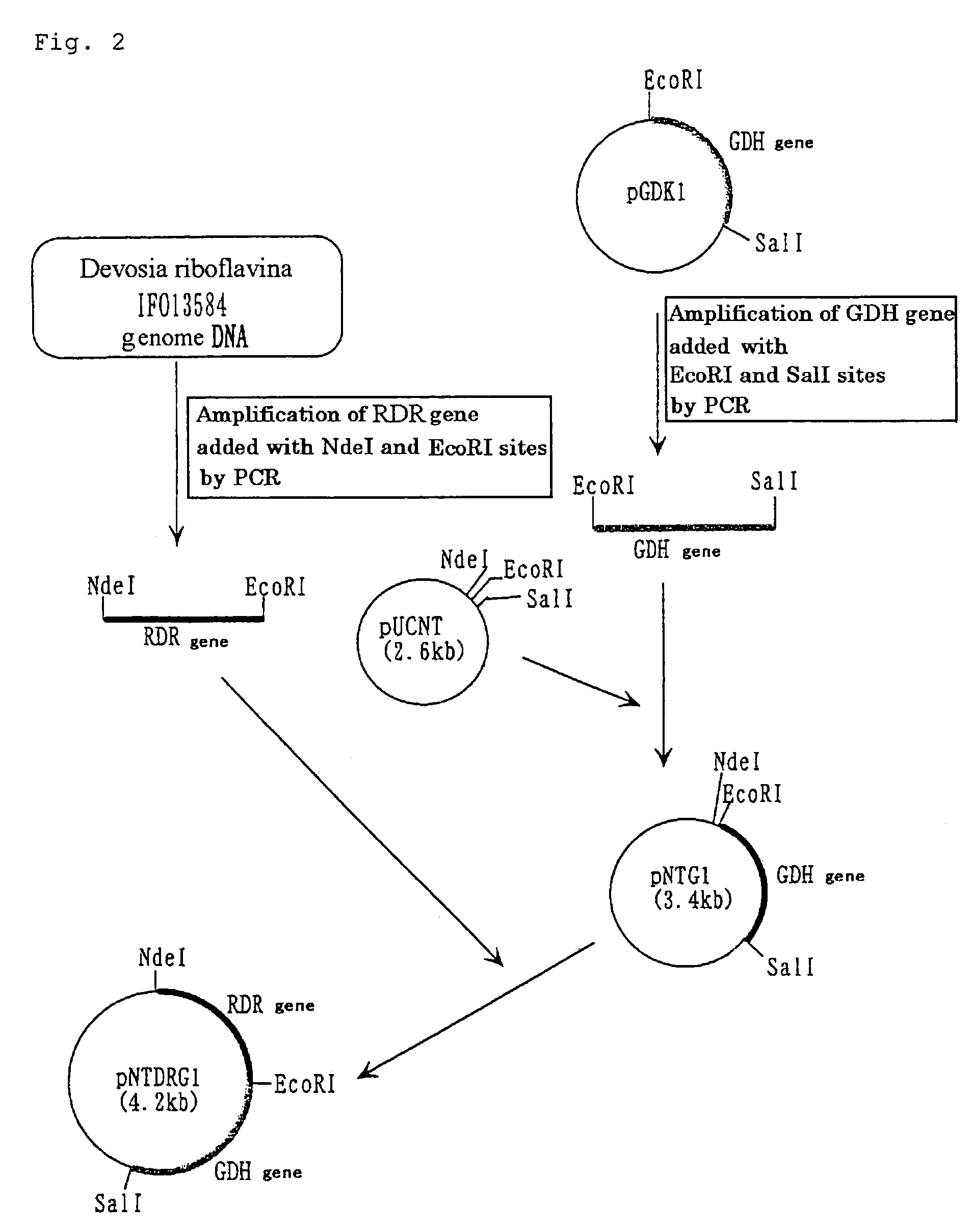Carbonyl reductase, gene thereof and method of using the same
a technology of carbonyl reductase and oxidizing enzyme, which is applied in the field of polypeptides, can solve the problems of low substrate concentration and low rate of conversion from substrate to product, and achieve the effect of high levels
- Summary
- Abstract
- Description
- Claims
- Application Information
AI Technical Summary
Benefits of technology
Problems solved by technology
Method used
Image
Examples
example 1
Enzyme Purification
[0090]An enzyme having activity in stereoselectively reducing N-benzyl-3-pyrrolidinone to form (R)-N-benzyl-3-pyrrolidinol was singly purified from Devosia riboflavina IFO 13584 according to the method described below. Unless otherwise specified, the purification procedure was carried out at 4° C.
(Cultivation of Devosia riboflavina IFO 13584)
[0091]400 ml of a liquid medium having the composition specified below was dispensed to 72 of 2 L Sakaguchi flasks and subjected to steam sterilization at 120° C. for 20 minutes.
Medium Composition (% Being Indicated as (w / v)):
[0092]
Polypeptone 1.0%Yeast extract 0.3%Meat extract 0.3%Malt extract 1.0%NaCl 0.3%Adekanol LG-109 (product of NOF Corp.)0.003%Tap waterpH 7.0
[0093]This medium was inoculated with a culture containing Devosia riboflavina IFO 13584 by 5 ml which has been precultured in advance in the same medium, and shaking cultivation was carried out at 30° C. for 48 hours.
(Preparation of a Cell-Free Extract)
[0094]Cells ...
example 2
Determination of Enzyme Properties
[0099]RDR obtained in Example 1 was investigated as to its enzymatic properties. Fundamentally, the enzyme activity was measured by adding the substrate N-benzyl-3-pyrrolidinone (5 mM), the coenzyme NADPH (0.25 mM) and the enzyme to 100 mM phosphate buffer (pH 6.5), allowing the reaction to proceed at 30° C. for 1 minute, and then measuring the decrease in absorbance at a wavelength of 340 nm.
(1) Activity:
[0100]In the presence of NADH as a coenzyme, the enzyme acted on N-benzyl-3-pyrrolidinone to form (R)-N-benzyl-3-pyrrolidinol with an optical purity of 99.9% ee or more. The enzyme activity measured with NADPH as a coenzyme by the above method was about 0.6% of the activity obtained by using NADH as a coenzyme.
(2) Optimum pH for Activity:
[0101]Enzyme activity measurements were carried out by the same enzyme activity measurement method as mentioned above except that the pH was varied in the range of 4.0 to 8.0 using, as the buffer, 100 mM phosphate ...
example 3
RDR Gene Cloning
(PCR Primer Preparation)
[0104]The purified enzyme RDR obtained in Example 1 was denatured in the presence of 8 M urea and then digested with lysyl endopeptidase derived from Achromobacter (product of Wako Pure Chemical Industries, Ltd.). The amino acid sequences of the resulting peptide fragments were determined using a model ABI 492 protein sequencer (product of PerkinElmer). Based on these amino acid sequences, two DNA primers (primer 1, SEQ ID NO:3; primer 2, SEQ ID NO:4) were synthesized in the conventional manner.
(RDR Gene Amplification by PCR)
[0105]Chromosomal DNA was extracted from cultured cells of Devosia riboflavina IFO 13584 by the method of Murray et al. (Nucl., Acids Res. 8: 4321–4325 (1980)). Then, using the DNA primers prepared as described above, PCR was carried out with the chromosomal DNA obtained as a template. A DNA fragment, about 700 bp in size and supposed to be part of the RDR gene, was amplified (PCR was carried out using TaKaRa Ex Taq (produ...
PUM
| Property | Measurement | Unit |
|---|---|---|
| pH | aaaaa | aaaaa |
| pH | aaaaa | aaaaa |
| temperature | aaaaa | aaaaa |
Abstract
Description
Claims
Application Information
 Login to view more
Login to view more - R&D Engineer
- R&D Manager
- IP Professional
- Industry Leading Data Capabilities
- Powerful AI technology
- Patent DNA Extraction
Browse by: Latest US Patents, China's latest patents, Technical Efficacy Thesaurus, Application Domain, Technology Topic.
© 2024 PatSnap. All rights reserved.Legal|Privacy policy|Modern Slavery Act Transparency Statement|Sitemap



